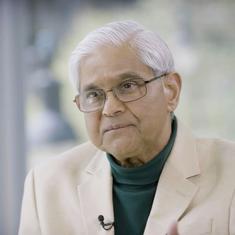It would be a travesty to choose between either of the knocks. And though the focus will be on the two centuries from Virat Kohli and AB de Villiers, at the end of the day, it was the spinners which proved the difference. With talk that the pitch would slow up in the build-up to the match, South Africa, burdened by injuries to key performers JP Duminy and Morne Morkel, shored up their spinning reserves, by bringing in Aaron Phangiso. Unfortunately for them, their spinners proved rather toothless against India’s batting – both Phangiso and Imran Tahir were hammered for a combined total of 109 runs in their 20 overs.
Spinning a web
In contrast, India’s spinners were deadly. South Africa’s batsmen, notwithstanding the early loss of Hashim Amla, looked completely at ease against the pacers in the early stages of their chase. But once Dhoni introduced his trio of spinners, they were utterly befuddled. It was a throwback to the days when overseas batsmen would struggle against spin in Indian conditions – South Africa’s batsmen were all at sea, pushing and prodding at the ball, completely unsure of which way the ball was turning. The strategy of opening with Hashim Amla seriously needs to be relooked – as one of South Africa’s best players against spin, he really should be slotted in the middle-order, especially as none of the other South African batsmen (apart from de Villiers) seem like they have the required technique to play spin.
Only one man held out. And though India had the upper hand throughout South Africa’s chase, it was a testament to de Villiers that India's victory was only assured when they saw his back. AB De Villiers could not have done more to keep South Africa in the hunt. He was sedate at the start, recognising that he was the only player who could counter India’s spinners but as wickets continued to fall around him, he went into overdrive after reaching his half-century. A scurry of big hits – including one particularly jaw-dropping boundary where he reverse cover-drived a Harbhajan Singh delivery – followed, but South Africa had dug themselves into too big a hole. Cramping at the end, De Villiers finally edge a tired heave through to Dhoni, finally putting the result beyond any doubt.
What South Africa’s supporting cast could not do for de Villiers, India’s did for Kohli. With the composition of the Indian batting order occupying much talktime of late, Ajinkya Rahane surprised a fair few when he walked in at number four. It turned out to be a good decision though – Rahane combined with Kohli to take India out of a precarious 35/2, providing a vital injection of momentum. Once Rahane left, there was another surprise to follow – despite Dhoni’s recent comments that he wanted to bat higher up the order, Suresh Raina came out. Thankfully, Raina, coming off a bad run of form, ensured that the momentum did not shift, scoring a rapid half-century to keep India on track for a total around the 300 mark.
A special Kohli century
Undoubtedly though, Kohli’s innings was a special one. What was unique about Kohli’s innings was there was no attempt by him to play a few overs and settle down – right from the first ball, he took on the bowling, ensuring that despite two early wickets, the South African bowlers were never on top. As soon as Phangiso came on, Kohli carted him over his head for a huge six to make his intentions clear. There were the usual Kohli specials – a neat dab off Tahir to the third-man fence, the flowing cover punches for four, and the usual exuberant celebration after reaching a thoroughly-deserved century.
An in-form Kohli is a supremely-dangerous Kohli and with the series now tied at 2-2 with an ODI in Mumbai left to settle it, South Africa have reason to worry. If the pitch in Wankhede starts turning, Dhoni will fancy his chances at clinching a series win that few had expected.
Fourth ODI: India (299 for 8 in 50 overs) beat South Africa (264 for 9 in 50 overs) by 35 runs.










